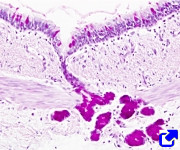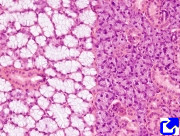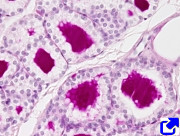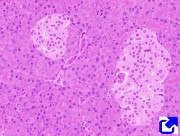To a greater or lesser extent, every cell may be regarded as secretory. However, some of them have become specialized in this cellular process. Secretion is the release of substances from cells to the extracellular milieu, having these substances a physiological purpose. Secretory cells are usually grouped to from glands, although it is not always so. A typical gland is a large and complex association of cells, and secretion is its main function. Sometimes, secretory cells are found in small groups or isolated, mostly found in covering epithelium. During the embryonary period, glands are originated from the covering epithelium (Figure 1), and they become exocrine or endocrine glands depending on where they release their products. Exocrine glands release their products to the external surfaces of the body (for example, skin, respiratory ducts and digestive duct). If the products are released into inner tissues and blood stream they are called endocrine glands.


Exocrine glands release their products to internal cavities or to the exterior of the body. Secretory cells release their products in different ways: directly to the exterior or into excretory ducts. For example, secretory intraepithelial cells release directly to the epithelial surfaces. These cells are usually isolated and scattered among non-secretory epithelial cells. They are known as unicellular secretory cells, such as caliciform cells of the gut epithelium. Sometimes, intraepithelial cells can be observed as small groups that do not protrude from the epithelial layer. They are known as intraepithelial glands.

In general, exocrine glands show more complex organizations. They may contain from one to many secretory parts that release their content into cavities. These cavities are connected to excretory ducts that drive the released substances to the exterior. Depending on the gland size, the excretory ducts are made up of simple or stratified cuboidal epithelia that connect secretory portions with the body surface. Secretory glands may become very complex in morphology, and are classified regarding the branching pattern of the excretory ducts and the organization of the secretory portions (see figure). Secretory cells are the production centers of the released products. Secretory cells may be organized in acini when they form very compact groups leaving little space for released products. When secretory cells leave a large space where the products can be released, the organization is called alveolar (Figure 2).


Secretory cells release their products by three different ways of secretion. a) Merocrine, when substances are released by typical exocytosis. b) Apocrine, when the apical domain of secretory cells are broken up into smaller pieces and are released along with vesicles that contain the secretory products. c) Holocrine, when cell breaks down and the whole cytoplasmic content is released (Figure 3).

Exocrine secretory cells release many types of molecules that carry out different functions, which are used as a classification character. For example, salivary glands are classified as mucous, serous, and mixed glands. Mucous exocrine glands release glycosaminoglycans, proteoglycans, and glycoproteins, which cover the internal body surfaces, whereas the serous glands mainly release enzymes that aid in the digestion of food. Mixed salivary glands release both. Up to four types of secretory cells can be found in a tubular gland of the stomach: mucous, chief, oxyntic and endocrine cells.


Endocrine glands do not have excretory ducts, and they release their products, such as hormones and proteins, to the extracellular space. From here, these products cross the blood vessel walls to be delivered to different parts of the body. There are many endocrine glands which are unicellular and together comprise the diffuse endocrine system. These endocrine unicellular glands can be intraepithelial cells located inside the gastrointestinal or respiratory cell epithelium, or between the cells of the hypophysis. However, most endocrine cells are arranged as cords or glomeruli, surrounded by a dense network of capillaries. The molecules to be released are no exocytosed immediately after they are synthesized, but they are stored in vesicles until a release signal arrives. Sometimes these products can be extracellularly stored in follicles, which are compartments formed by secretory cells. This type of follicle can be found in the thyroid gland. In the adrenal gland, several types of endocrine cells that release different types of secretory products are located together.

In the pancreas, exocrine and endocrine glands coexist. The exocrine part releases secretory products into the gut. The Langerhans islets form the endocrine part of the pancreas.
Some epithelial cells, and other types of cells, release substances within the surrounding tissue, but they are not intended to enter the bloodstream. Such products diffuse through the extracellular matrix and act on neighboring cells. It is called paracrine secretion.
-
Bibliografía ↷
-
Bibliografía
Krstić, EV. 1989. Los tejidos del hombre y de los mamíferos. McGraw-Hill-Interamericana. Madrid.
-
 Covering epithelium
Covering epithelium